Exploring Contract Law and Legal Dispute Resolution in the UK
VerifiedAdded on 2020/06/04
|15
|5269
|341
AI Summary
The essay delves into the principles underpinning contract law in the United Kingdom, highlighting its evolution and current status. Contract law is central to regulating agreements between parties, ensuring that mutual obligations are legally enforceable. The discussion includes key elements of a valid contract, such as offer, acceptance, consideration, intention to create legal relations, and capacity. Additionally, it explores various remedies for breach of contract, including damages, specific performance, rescission, and restitution. Beyond litigation in courts, the essay examines alternative dispute resolution mechanisms like arbitration and mediation, which provide parties with efficient, private means of resolving disputes without resorting to formal court proceedings. The effectiveness of these methods is evaluated within the context of legal reform initiatives aimed at improving accessibility and efficiency in the UK justice system. By understanding both the theoretical aspects of contract law and practical approaches to dispute resolution, this essay offers a comprehensive insight into how legal frameworks support commercial interactions and uphold justice.
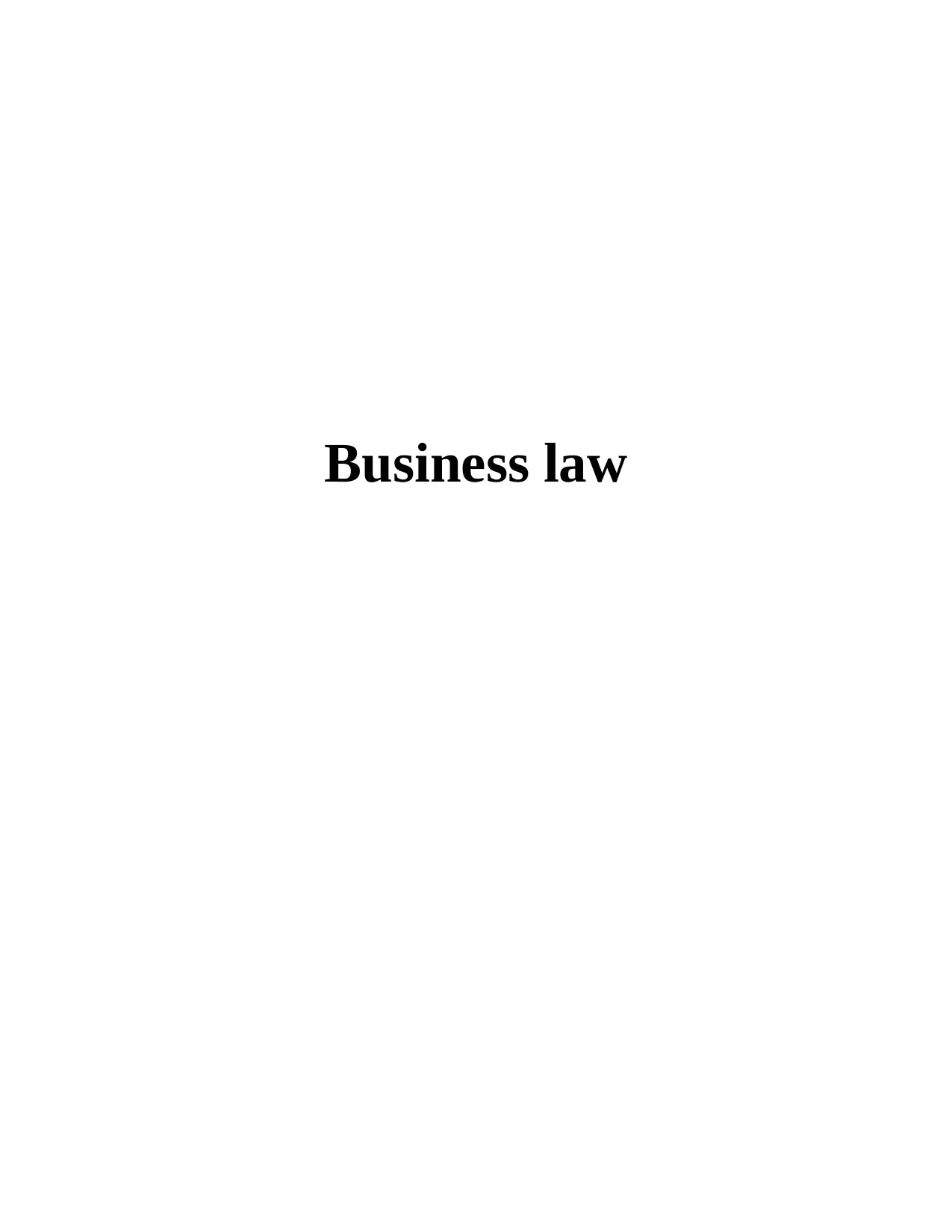
Business law
Paraphrase This Document
Need a fresh take? Get an instant paraphrase of this document with our AI Paraphraser

TABLE OF CONTENTS
INTRODUCTION...........................................................................................................................1
SECTION 1......................................................................................................................................1
P1 Structure of English legal system and different sources of law........................................1
P2 Role of government in making law and application of statutory and common law..........3
M1 Effectiveness of legal system in terms of reforms and developments.............................4
D1 Critical evaluation of English legal system......................................................................5
SECTION 2......................................................................................................................................5
P3 a) Employers legislations in relation to:............................................................................5
b) Relevant employment and contract laws............................................................................6
M2 Potential effect of legislations, regulations and standards in context of case study........6
SECTION 3......................................................................................................................................7
P4 Appropriate legal solutions for business problems...........................................................7
P5 Justifications for solutions in context of above case.........................................................8
M3 Positive and negative impacts of legal solutions to business problems...........................9
SECTION 4......................................................................................................................................9
P6 a) Concepts and benefits of using alternative dispute resolution process.........................9
P6 b) Legal solutions for business problems........................................................................10
M4 Effectiveness of two different recommendations..........................................................10
CONCLUSION..............................................................................................................................11
REFERENCES..............................................................................................................................12
INTRODUCTION...........................................................................................................................1
SECTION 1......................................................................................................................................1
P1 Structure of English legal system and different sources of law........................................1
P2 Role of government in making law and application of statutory and common law..........3
M1 Effectiveness of legal system in terms of reforms and developments.............................4
D1 Critical evaluation of English legal system......................................................................5
SECTION 2......................................................................................................................................5
P3 a) Employers legislations in relation to:............................................................................5
b) Relevant employment and contract laws............................................................................6
M2 Potential effect of legislations, regulations and standards in context of case study........6
SECTION 3......................................................................................................................................7
P4 Appropriate legal solutions for business problems...........................................................7
P5 Justifications for solutions in context of above case.........................................................8
M3 Positive and negative impacts of legal solutions to business problems...........................9
SECTION 4......................................................................................................................................9
P6 a) Concepts and benefits of using alternative dispute resolution process.........................9
P6 b) Legal solutions for business problems........................................................................10
M4 Effectiveness of two different recommendations..........................................................10
CONCLUSION..............................................................................................................................11
REFERENCES..............................................................................................................................12
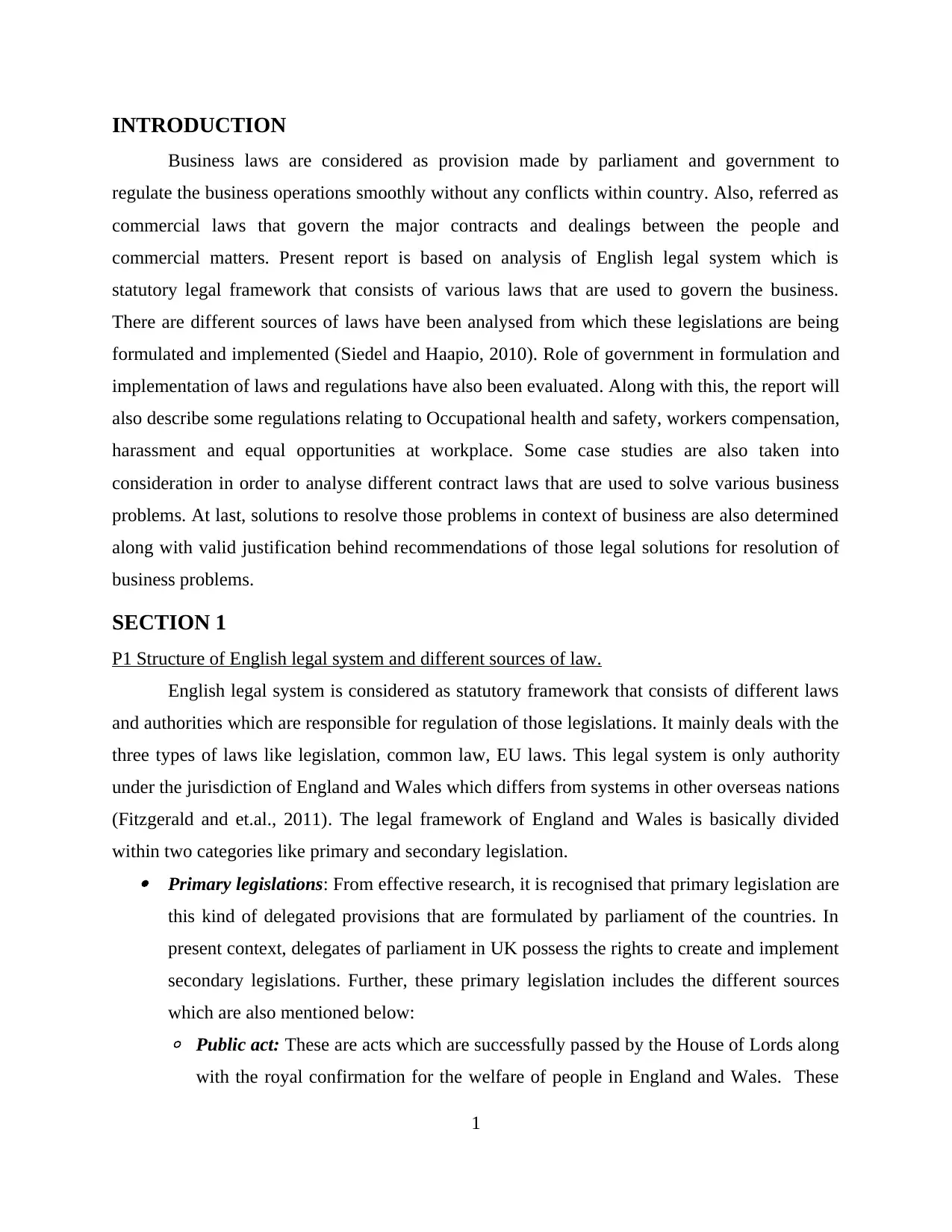
INTRODUCTION
Business laws are considered as provision made by parliament and government to
regulate the business operations smoothly without any conflicts within country. Also, referred as
commercial laws that govern the major contracts and dealings between the people and
commercial matters. Present report is based on analysis of English legal system which is
statutory legal framework that consists of various laws that are used to govern the business.
There are different sources of laws have been analysed from which these legislations are being
formulated and implemented (Siedel and Haapio, 2010). Role of government in formulation and
implementation of laws and regulations have also been evaluated. Along with this, the report will
also describe some regulations relating to Occupational health and safety, workers compensation,
harassment and equal opportunities at workplace. Some case studies are also taken into
consideration in order to analyse different contract laws that are used to solve various business
problems. At last, solutions to resolve those problems in context of business are also determined
along with valid justification behind recommendations of those legal solutions for resolution of
business problems.
SECTION 1
P1 Structure of English legal system and different sources of law.
English legal system is considered as statutory framework that consists of different laws
and authorities which are responsible for regulation of those legislations. It mainly deals with the
three types of laws like legislation, common law, EU laws. This legal system is only authority
under the jurisdiction of England and Wales which differs from systems in other overseas nations
(Fitzgerald and et.al., 2011). The legal framework of England and Wales is basically divided
within two categories like primary and secondary legislation. Primary legislations: From effective research, it is recognised that primary legislation are
this kind of delegated provisions that are formulated by parliament of the countries. In
present context, delegates of parliament in UK possess the rights to create and implement
secondary legislations. Further, these primary legislation includes the different sources
which are also mentioned below:
◦ Public act: These are acts which are successfully passed by the House of Lords along
with the royal confirmation for the welfare of people in England and Wales. These
1
Business laws are considered as provision made by parliament and government to
regulate the business operations smoothly without any conflicts within country. Also, referred as
commercial laws that govern the major contracts and dealings between the people and
commercial matters. Present report is based on analysis of English legal system which is
statutory legal framework that consists of various laws that are used to govern the business.
There are different sources of laws have been analysed from which these legislations are being
formulated and implemented (Siedel and Haapio, 2010). Role of government in formulation and
implementation of laws and regulations have also been evaluated. Along with this, the report will
also describe some regulations relating to Occupational health and safety, workers compensation,
harassment and equal opportunities at workplace. Some case studies are also taken into
consideration in order to analyse different contract laws that are used to solve various business
problems. At last, solutions to resolve those problems in context of business are also determined
along with valid justification behind recommendations of those legal solutions for resolution of
business problems.
SECTION 1
P1 Structure of English legal system and different sources of law.
English legal system is considered as statutory framework that consists of different laws
and authorities which are responsible for regulation of those legislations. It mainly deals with the
three types of laws like legislation, common law, EU laws. This legal system is only authority
under the jurisdiction of England and Wales which differs from systems in other overseas nations
(Fitzgerald and et.al., 2011). The legal framework of England and Wales is basically divided
within two categories like primary and secondary legislation. Primary legislations: From effective research, it is recognised that primary legislation are
this kind of delegated provisions that are formulated by parliament of the countries. In
present context, delegates of parliament in UK possess the rights to create and implement
secondary legislations. Further, these primary legislation includes the different sources
which are also mentioned below:
◦ Public act: These are acts which are successfully passed by the House of Lords along
with the royal confirmation for the welfare of people in England and Wales. These
1
⊘ This is a preview!⊘
Do you want full access?
Subscribe today to unlock all pages.

Trusted by 1+ million students worldwide

acts have been formulated by government within aim to provide certain rights to the
people and provide them a base to regulations. For example: Transport Act 2000,
General Act 1998 and Housing Act 1963 etc.
◦ Local and personal act: Provisions under both local and personal act are included in
private acts which formulated with an aim to govern the individual and organization
business operations (Gillers, 2014). Local provision involves the benefit of
organisation, limits of corporates and grants of citizenship etc.
◦ Privacy council: It is also considered as part of royal limits, these laws and provisions
have been changed simultaneously by act of House of Lords and involve the civil
services and appointments of prime ministers. Other than this, it also includes civil
contingency, statutory instruments, and government of Wales act 2006. Secondary legislations: Statutory legal provisions which are made by the representative
of primary authority of regulations. In present case, these legal provision have been made
to protect the people from certain damages and aims to operate smooth business
operations. Territorial acts 1973, national assembly of Wales acts, Ireland act 1973 and
warranty and regulations acts are major example of these secondary provisions. It
includes two types of laws like:
◦ Common laws: Also considered as case laws made by the judges of supreme courts
used to provide judgements for some cases based on similar situations (Kötz, 2017).
These case laws involve criminal laws, contract laws, tort laws and agency terms and
conditions. In UK, common legislation also recognised as civil laws but they also
differ due to their different sources of generation.
◦ EU Laws: These are statutory legal provision which are also analysed as civil laws
made by the European Union to protect the rights of people living, employed and
business enterprises in Europe (Mnookin and Weisberg, 2014). In case of UK,
partnership act 1890, laws of property act 1925 and sales of goods act 1893 are the
best example of these civil laws.
◦ Statutes: It implies to laws formulated by House of Lords along with the government
which are mandatory for all the people and amendments have done continuously in
2
people and provide them a base to regulations. For example: Transport Act 2000,
General Act 1998 and Housing Act 1963 etc.
◦ Local and personal act: Provisions under both local and personal act are included in
private acts which formulated with an aim to govern the individual and organization
business operations (Gillers, 2014). Local provision involves the benefit of
organisation, limits of corporates and grants of citizenship etc.
◦ Privacy council: It is also considered as part of royal limits, these laws and provisions
have been changed simultaneously by act of House of Lords and involve the civil
services and appointments of prime ministers. Other than this, it also includes civil
contingency, statutory instruments, and government of Wales act 2006. Secondary legislations: Statutory legal provisions which are made by the representative
of primary authority of regulations. In present case, these legal provision have been made
to protect the people from certain damages and aims to operate smooth business
operations. Territorial acts 1973, national assembly of Wales acts, Ireland act 1973 and
warranty and regulations acts are major example of these secondary provisions. It
includes two types of laws like:
◦ Common laws: Also considered as case laws made by the judges of supreme courts
used to provide judgements for some cases based on similar situations (Kötz, 2017).
These case laws involve criminal laws, contract laws, tort laws and agency terms and
conditions. In UK, common legislation also recognised as civil laws but they also
differ due to their different sources of generation.
◦ EU Laws: These are statutory legal provision which are also analysed as civil laws
made by the European Union to protect the rights of people living, employed and
business enterprises in Europe (Mnookin and Weisberg, 2014). In case of UK,
partnership act 1890, laws of property act 1925 and sales of goods act 1893 are the
best example of these civil laws.
◦ Statutes: It implies to laws formulated by House of Lords along with the government
which are mandatory for all the people and amendments have done continuously in
2
Paraphrase This Document
Need a fresh take? Get an instant paraphrase of this document with our AI Paraphraser
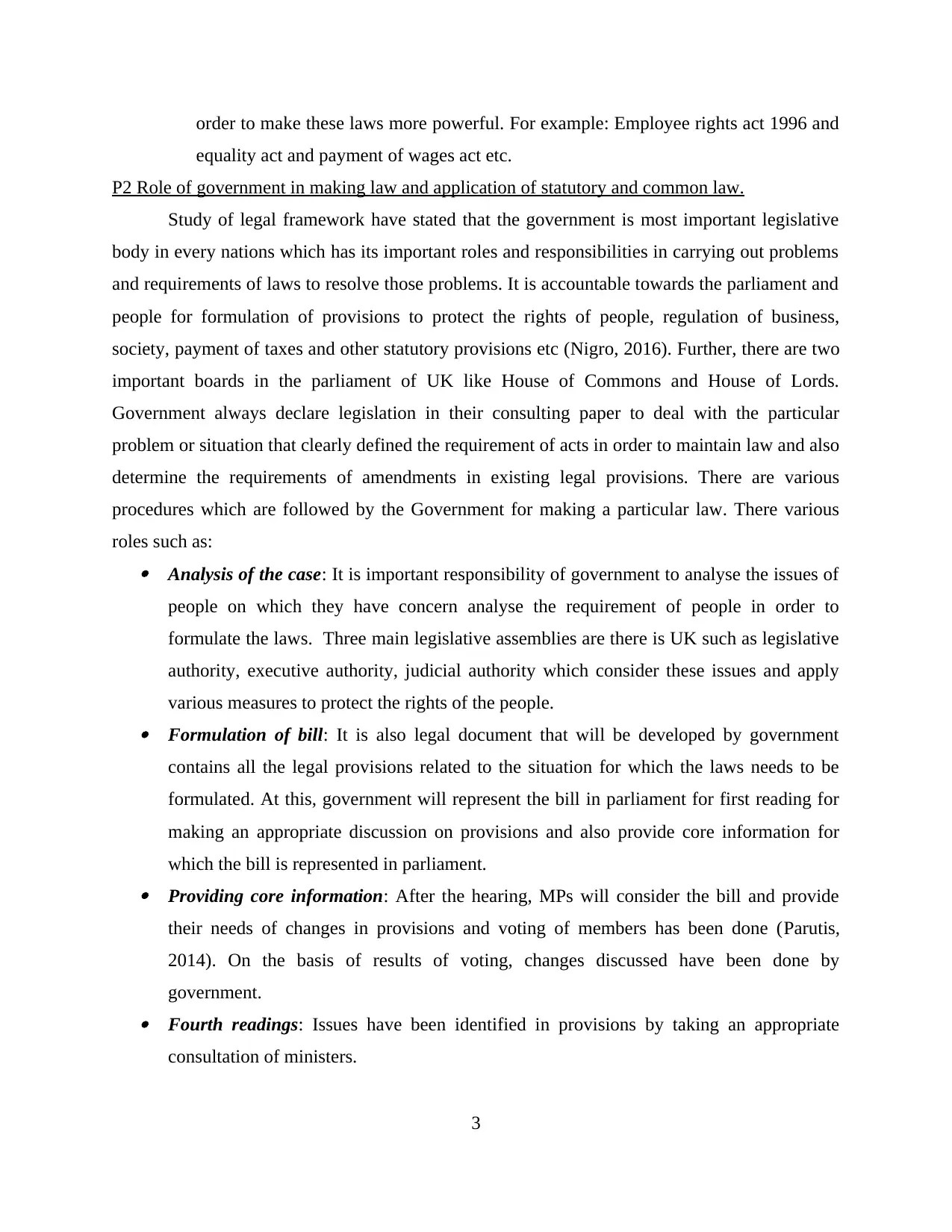
order to make these laws more powerful. For example: Employee rights act 1996 and
equality act and payment of wages act etc.
P2 Role of government in making law and application of statutory and common law.
Study of legal framework have stated that the government is most important legislative
body in every nations which has its important roles and responsibilities in carrying out problems
and requirements of laws to resolve those problems. It is accountable towards the parliament and
people for formulation of provisions to protect the rights of people, regulation of business,
society, payment of taxes and other statutory provisions etc (Nigro, 2016). Further, there are two
important boards in the parliament of UK like House of Commons and House of Lords.
Government always declare legislation in their consulting paper to deal with the particular
problem or situation that clearly defined the requirement of acts in order to maintain law and also
determine the requirements of amendments in existing legal provisions. There are various
procedures which are followed by the Government for making a particular law. There various
roles such as: Analysis of the case: It is important responsibility of government to analyse the issues of
people on which they have concern analyse the requirement of people in order to
formulate the laws. Three main legislative assemblies are there is UK such as legislative
authority, executive authority, judicial authority which consider these issues and apply
various measures to protect the rights of the people. Formulation of bill: It is also legal document that will be developed by government
contains all the legal provisions related to the situation for which the laws needs to be
formulated. At this, government will represent the bill in parliament for first reading for
making an appropriate discussion on provisions and also provide core information for
which the bill is represented in parliament. Providing core information: After the hearing, MPs will consider the bill and provide
their needs of changes in provisions and voting of members has been done (Parutis,
2014). On the basis of results of voting, changes discussed have been done by
government. Fourth readings: Issues have been identified in provisions by taking an appropriate
consultation of ministers.
3
equality act and payment of wages act etc.
P2 Role of government in making law and application of statutory and common law.
Study of legal framework have stated that the government is most important legislative
body in every nations which has its important roles and responsibilities in carrying out problems
and requirements of laws to resolve those problems. It is accountable towards the parliament and
people for formulation of provisions to protect the rights of people, regulation of business,
society, payment of taxes and other statutory provisions etc (Nigro, 2016). Further, there are two
important boards in the parliament of UK like House of Commons and House of Lords.
Government always declare legislation in their consulting paper to deal with the particular
problem or situation that clearly defined the requirement of acts in order to maintain law and also
determine the requirements of amendments in existing legal provisions. There are various
procedures which are followed by the Government for making a particular law. There various
roles such as: Analysis of the case: It is important responsibility of government to analyse the issues of
people on which they have concern analyse the requirement of people in order to
formulate the laws. Three main legislative assemblies are there is UK such as legislative
authority, executive authority, judicial authority which consider these issues and apply
various measures to protect the rights of the people. Formulation of bill: It is also legal document that will be developed by government
contains all the legal provisions related to the situation for which the laws needs to be
formulated. At this, government will represent the bill in parliament for first reading for
making an appropriate discussion on provisions and also provide core information for
which the bill is represented in parliament. Providing core information: After the hearing, MPs will consider the bill and provide
their needs of changes in provisions and voting of members has been done (Parutis,
2014). On the basis of results of voting, changes discussed have been done by
government. Fourth readings: Issues have been identified in provisions by taking an appropriate
consultation of ministers.
3
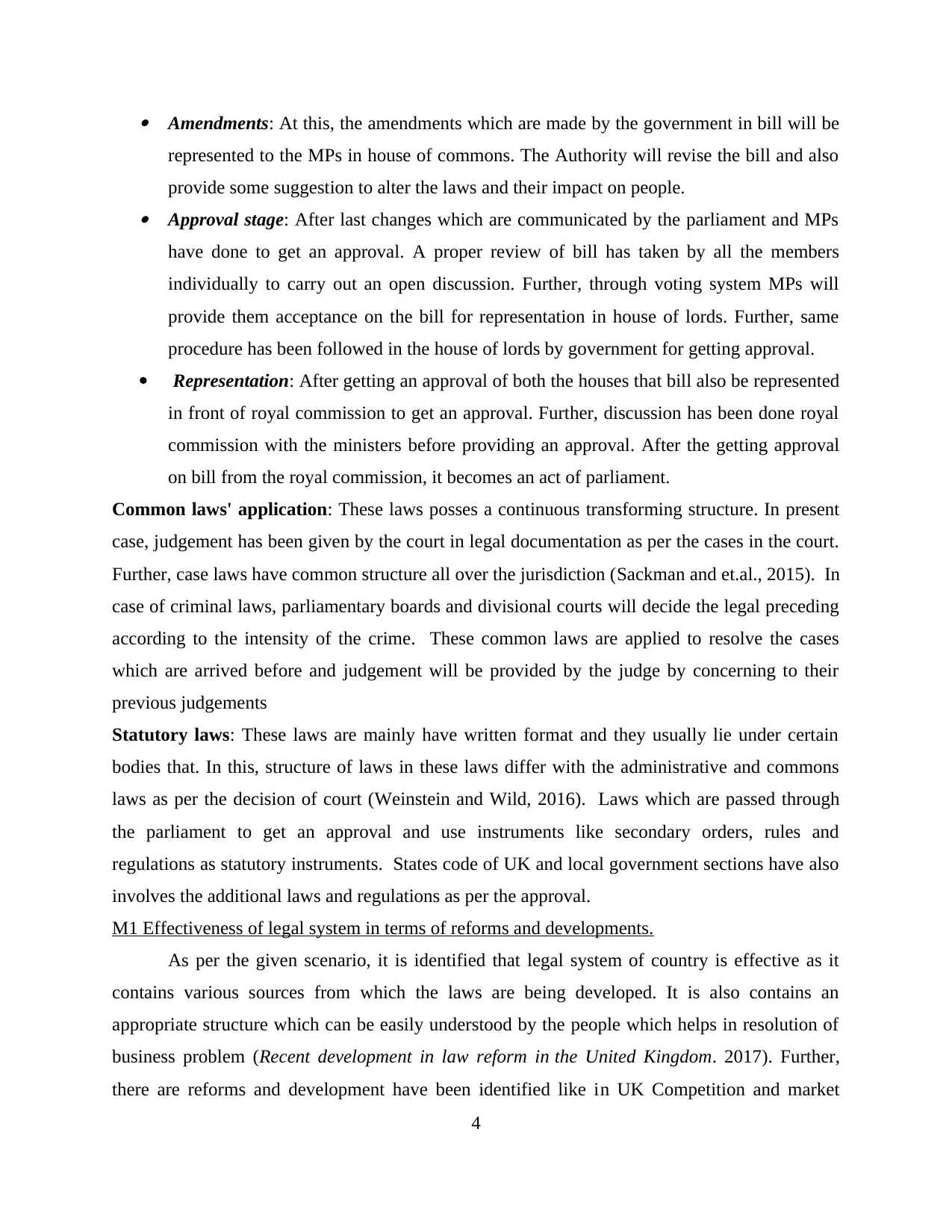
Amendments: At this, the amendments which are made by the government in bill will be
represented to the MPs in house of commons. The Authority will revise the bill and also
provide some suggestion to alter the laws and their impact on people. Approval stage: After last changes which are communicated by the parliament and MPs
have done to get an approval. A proper review of bill has taken by all the members
individually to carry out an open discussion. Further, through voting system MPs will
provide them acceptance on the bill for representation in house of lords. Further, same
procedure has been followed in the house of lords by government for getting approval.
Representation: After getting an approval of both the houses that bill also be represented
in front of royal commission to get an approval. Further, discussion has been done royal
commission with the ministers before providing an approval. After the getting approval
on bill from the royal commission, it becomes an act of parliament.
Common laws' application: These laws posses a continuous transforming structure. In present
case, judgement has been given by the court in legal documentation as per the cases in the court.
Further, case laws have common structure all over the jurisdiction (Sackman and et.al., 2015). In
case of criminal laws, parliamentary boards and divisional courts will decide the legal preceding
according to the intensity of the crime. These common laws are applied to resolve the cases
which are arrived before and judgement will be provided by the judge by concerning to their
previous judgements
Statutory laws: These laws are mainly have written format and they usually lie under certain
bodies that. In this, structure of laws in these laws differ with the administrative and commons
laws as per the decision of court (Weinstein and Wild, 2016). Laws which are passed through
the parliament to get an approval and use instruments like secondary orders, rules and
regulations as statutory instruments. States code of UK and local government sections have also
involves the additional laws and regulations as per the approval.
M1 Effectiveness of legal system in terms of reforms and developments.
As per the given scenario, it is identified that legal system of country is effective as it
contains various sources from which the laws are being developed. It is also contains an
appropriate structure which can be easily understood by the people which helps in resolution of
business problem (Recent development in law reform in the United Kingdom. 2017). Further,
there are reforms and development have been identified like in UK Competition and market
4
represented to the MPs in house of commons. The Authority will revise the bill and also
provide some suggestion to alter the laws and their impact on people. Approval stage: After last changes which are communicated by the parliament and MPs
have done to get an approval. A proper review of bill has taken by all the members
individually to carry out an open discussion. Further, through voting system MPs will
provide them acceptance on the bill for representation in house of lords. Further, same
procedure has been followed in the house of lords by government for getting approval.
Representation: After getting an approval of both the houses that bill also be represented
in front of royal commission to get an approval. Further, discussion has been done royal
commission with the ministers before providing an approval. After the getting approval
on bill from the royal commission, it becomes an act of parliament.
Common laws' application: These laws posses a continuous transforming structure. In present
case, judgement has been given by the court in legal documentation as per the cases in the court.
Further, case laws have common structure all over the jurisdiction (Sackman and et.al., 2015). In
case of criminal laws, parliamentary boards and divisional courts will decide the legal preceding
according to the intensity of the crime. These common laws are applied to resolve the cases
which are arrived before and judgement will be provided by the judge by concerning to their
previous judgements
Statutory laws: These laws are mainly have written format and they usually lie under certain
bodies that. In this, structure of laws in these laws differ with the administrative and commons
laws as per the decision of court (Weinstein and Wild, 2016). Laws which are passed through
the parliament to get an approval and use instruments like secondary orders, rules and
regulations as statutory instruments. States code of UK and local government sections have also
involves the additional laws and regulations as per the approval.
M1 Effectiveness of legal system in terms of reforms and developments.
As per the given scenario, it is identified that legal system of country is effective as it
contains various sources from which the laws are being developed. It is also contains an
appropriate structure which can be easily understood by the people which helps in resolution of
business problem (Recent development in law reform in the United Kingdom. 2017). Further,
there are reforms and development have been identified like in UK Competition and market
4
⊘ This is a preview!⊘
Do you want full access?
Subscribe today to unlock all pages.

Trusted by 1+ million students worldwide
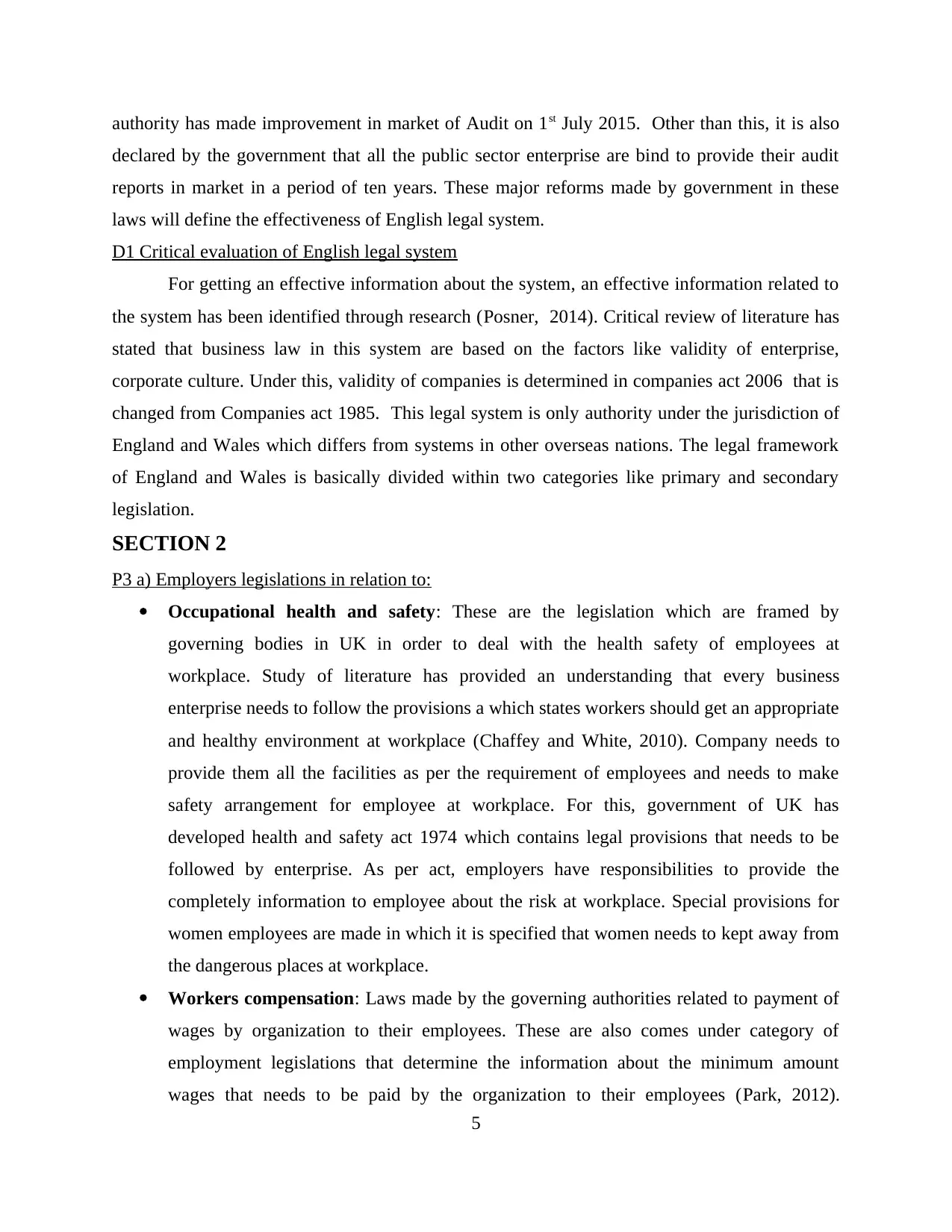
authority has made improvement in market of Audit on 1st July 2015. Other than this, it is also
declared by the government that all the public sector enterprise are bind to provide their audit
reports in market in a period of ten years. These major reforms made by government in these
laws will define the effectiveness of English legal system.
D1 Critical evaluation of English legal system
For getting an effective information about the system, an effective information related to
the system has been identified through research (Posner, 2014). Critical review of literature has
stated that business law in this system are based on the factors like validity of enterprise,
corporate culture. Under this, validity of companies is determined in companies act 2006 that is
changed from Companies act 1985. This legal system is only authority under the jurisdiction of
England and Wales which differs from systems in other overseas nations. The legal framework
of England and Wales is basically divided within two categories like primary and secondary
legislation.
SECTION 2
P3 a) Employers legislations in relation to:
Occupational health and safety: These are the legislation which are framed by
governing bodies in UK in order to deal with the health safety of employees at
workplace. Study of literature has provided an understanding that every business
enterprise needs to follow the provisions a which states workers should get an appropriate
and healthy environment at workplace (Chaffey and White, 2010). Company needs to
provide them all the facilities as per the requirement of employees and needs to make
safety arrangement for employee at workplace. For this, government of UK has
developed health and safety act 1974 which contains legal provisions that needs to be
followed by enterprise. As per act, employers have responsibilities to provide the
completely information to employee about the risk at workplace. Special provisions for
women employees are made in which it is specified that women needs to kept away from
the dangerous places at workplace.
Workers compensation: Laws made by the governing authorities related to payment of
wages by organization to their employees. These are also comes under category of
employment legislations that determine the information about the minimum amount
wages that needs to be paid by the organization to their employees (Park, 2012).
5
declared by the government that all the public sector enterprise are bind to provide their audit
reports in market in a period of ten years. These major reforms made by government in these
laws will define the effectiveness of English legal system.
D1 Critical evaluation of English legal system
For getting an effective information about the system, an effective information related to
the system has been identified through research (Posner, 2014). Critical review of literature has
stated that business law in this system are based on the factors like validity of enterprise,
corporate culture. Under this, validity of companies is determined in companies act 2006 that is
changed from Companies act 1985. This legal system is only authority under the jurisdiction of
England and Wales which differs from systems in other overseas nations. The legal framework
of England and Wales is basically divided within two categories like primary and secondary
legislation.
SECTION 2
P3 a) Employers legislations in relation to:
Occupational health and safety: These are the legislation which are framed by
governing bodies in UK in order to deal with the health safety of employees at
workplace. Study of literature has provided an understanding that every business
enterprise needs to follow the provisions a which states workers should get an appropriate
and healthy environment at workplace (Chaffey and White, 2010). Company needs to
provide them all the facilities as per the requirement of employees and needs to make
safety arrangement for employee at workplace. For this, government of UK has
developed health and safety act 1974 which contains legal provisions that needs to be
followed by enterprise. As per act, employers have responsibilities to provide the
completely information to employee about the risk at workplace. Special provisions for
women employees are made in which it is specified that women needs to kept away from
the dangerous places at workplace.
Workers compensation: Laws made by the governing authorities related to payment of
wages by organization to their employees. These are also comes under category of
employment legislations that determine the information about the minimum amount
wages that needs to be paid by the organization to their employees (Park, 2012).
5
Paraphrase This Document
Need a fresh take? Get an instant paraphrase of this document with our AI Paraphraser
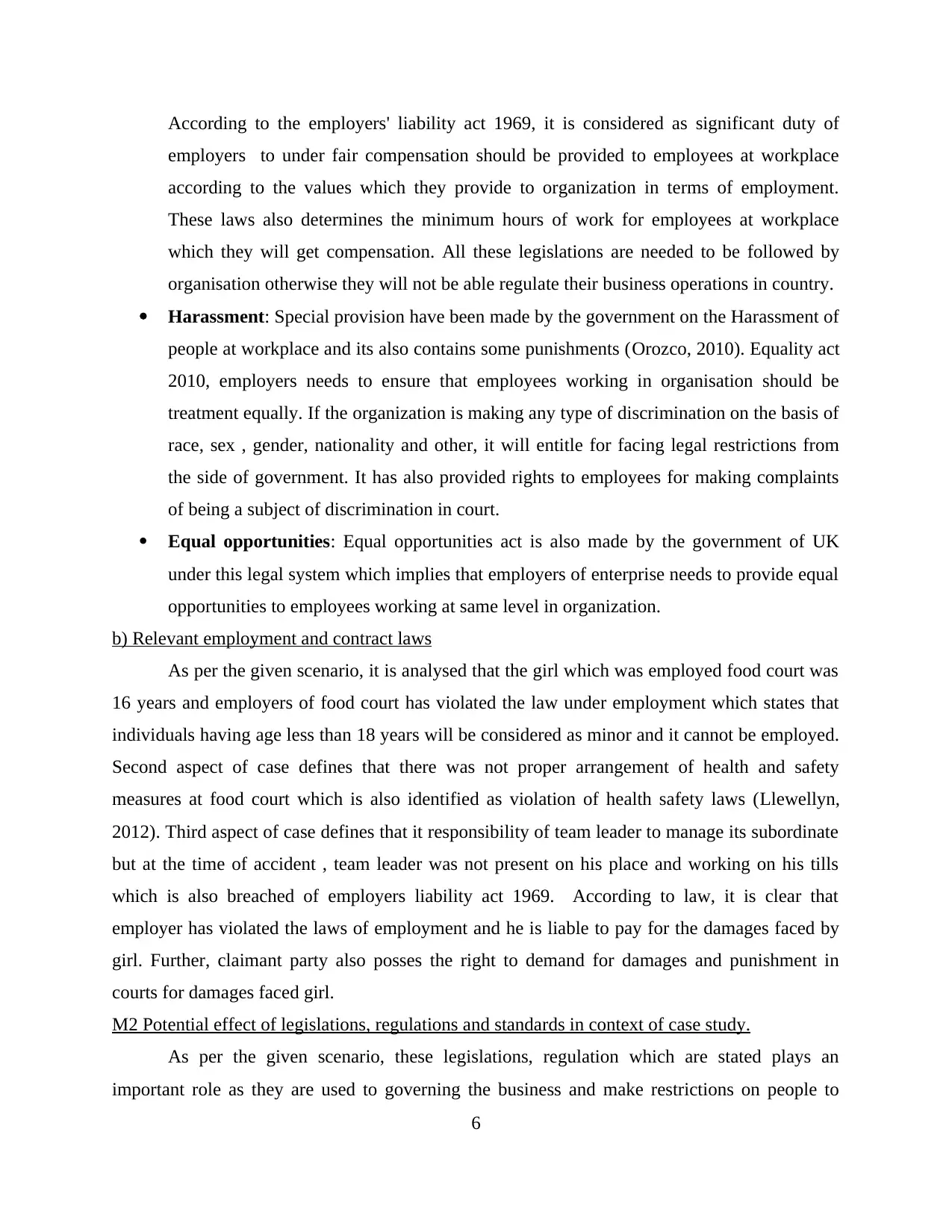
According to the employers' liability act 1969, it is considered as significant duty of
employers to under fair compensation should be provided to employees at workplace
according to the values which they provide to organization in terms of employment.
These laws also determines the minimum hours of work for employees at workplace
which they will get compensation. All these legislations are needed to be followed by
organisation otherwise they will not be able regulate their business operations in country.
Harassment: Special provision have been made by the government on the Harassment of
people at workplace and its also contains some punishments (Orozco, 2010). Equality act
2010, employers needs to ensure that employees working in organisation should be
treatment equally. If the organization is making any type of discrimination on the basis of
race, sex , gender, nationality and other, it will entitle for facing legal restrictions from
the side of government. It has also provided rights to employees for making complaints
of being a subject of discrimination in court.
Equal opportunities: Equal opportunities act is also made by the government of UK
under this legal system which implies that employers of enterprise needs to provide equal
opportunities to employees working at same level in organization.
b) Relevant employment and contract laws
As per the given scenario, it is analysed that the girl which was employed food court was
16 years and employers of food court has violated the law under employment which states that
individuals having age less than 18 years will be considered as minor and it cannot be employed.
Second aspect of case defines that there was not proper arrangement of health and safety
measures at food court which is also identified as violation of health safety laws (Llewellyn,
2012). Third aspect of case defines that it responsibility of team leader to manage its subordinate
but at the time of accident , team leader was not present on his place and working on his tills
which is also breached of employers liability act 1969. According to law, it is clear that
employer has violated the laws of employment and he is liable to pay for the damages faced by
girl. Further, claimant party also posses the right to demand for damages and punishment in
courts for damages faced girl.
M2 Potential effect of legislations, regulations and standards in context of case study.
As per the given scenario, these legislations, regulation which are stated plays an
important role as they are used to governing the business and make restrictions on people to
6
employers to under fair compensation should be provided to employees at workplace
according to the values which they provide to organization in terms of employment.
These laws also determines the minimum hours of work for employees at workplace
which they will get compensation. All these legislations are needed to be followed by
organisation otherwise they will not be able regulate their business operations in country.
Harassment: Special provision have been made by the government on the Harassment of
people at workplace and its also contains some punishments (Orozco, 2010). Equality act
2010, employers needs to ensure that employees working in organisation should be
treatment equally. If the organization is making any type of discrimination on the basis of
race, sex , gender, nationality and other, it will entitle for facing legal restrictions from
the side of government. It has also provided rights to employees for making complaints
of being a subject of discrimination in court.
Equal opportunities: Equal opportunities act is also made by the government of UK
under this legal system which implies that employers of enterprise needs to provide equal
opportunities to employees working at same level in organization.
b) Relevant employment and contract laws
As per the given scenario, it is analysed that the girl which was employed food court was
16 years and employers of food court has violated the law under employment which states that
individuals having age less than 18 years will be considered as minor and it cannot be employed.
Second aspect of case defines that there was not proper arrangement of health and safety
measures at food court which is also identified as violation of health safety laws (Llewellyn,
2012). Third aspect of case defines that it responsibility of team leader to manage its subordinate
but at the time of accident , team leader was not present on his place and working on his tills
which is also breached of employers liability act 1969. According to law, it is clear that
employer has violated the laws of employment and he is liable to pay for the damages faced by
girl. Further, claimant party also posses the right to demand for damages and punishment in
courts for damages faced girl.
M2 Potential effect of legislations, regulations and standards in context of case study.
As per the given scenario, these legislations, regulation which are stated plays an
important role as they are used to governing the business and make restrictions on people to
6
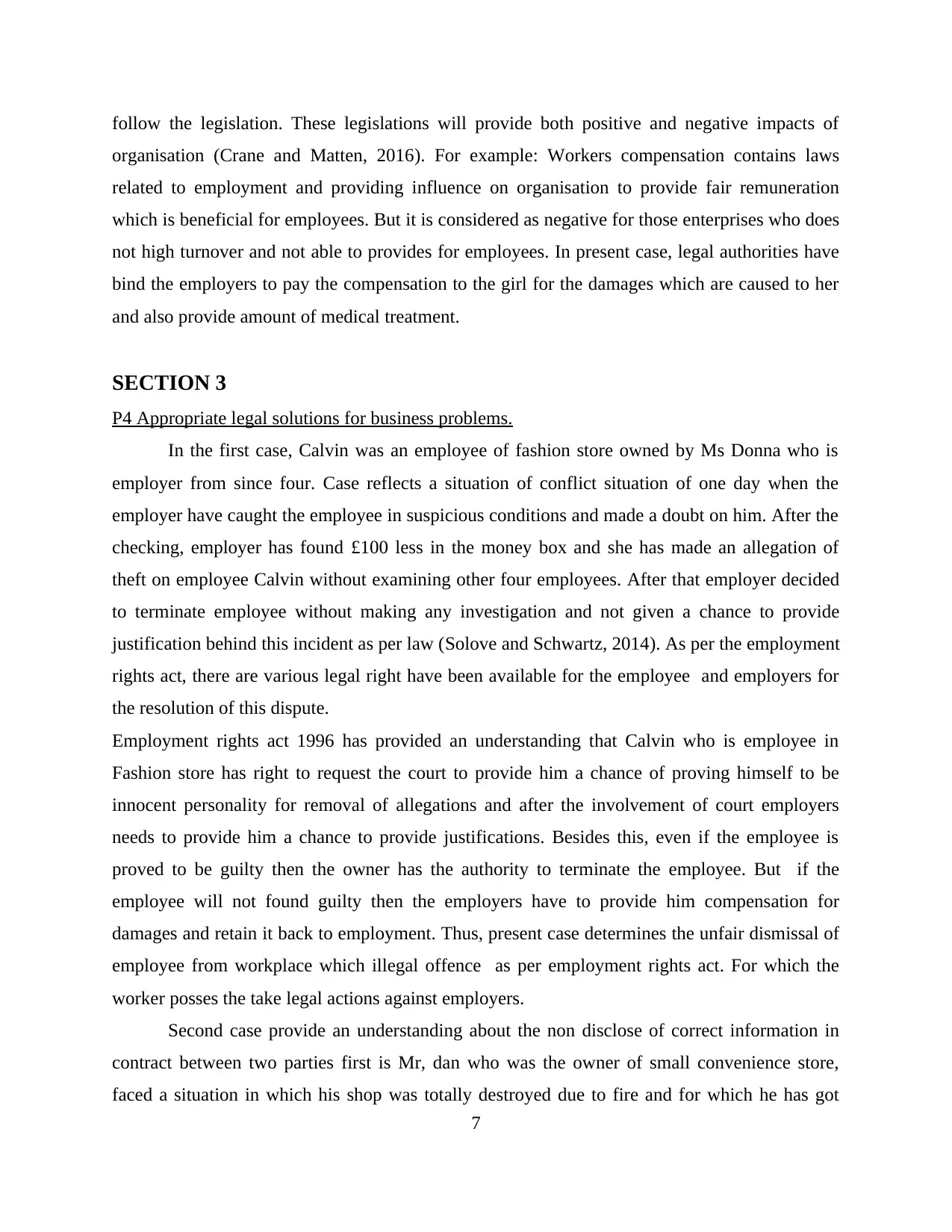
follow the legislation. These legislations will provide both positive and negative impacts of
organisation (Crane and Matten, 2016). For example: Workers compensation contains laws
related to employment and providing influence on organisation to provide fair remuneration
which is beneficial for employees. But it is considered as negative for those enterprises who does
not high turnover and not able to provides for employees. In present case, legal authorities have
bind the employers to pay the compensation to the girl for the damages which are caused to her
and also provide amount of medical treatment.
SECTION 3
P4 Appropriate legal solutions for business problems.
In the first case, Calvin was an employee of fashion store owned by Ms Donna who is
employer from since four. Case reflects a situation of conflict situation of one day when the
employer have caught the employee in suspicious conditions and made a doubt on him. After the
checking, employer has found £100 less in the money box and she has made an allegation of
theft on employee Calvin without examining other four employees. After that employer decided
to terminate employee without making any investigation and not given a chance to provide
justification behind this incident as per law (Solove and Schwartz, 2014). As per the employment
rights act, there are various legal right have been available for the employee and employers for
the resolution of this dispute.
Employment rights act 1996 has provided an understanding that Calvin who is employee in
Fashion store has right to request the court to provide him a chance of proving himself to be
innocent personality for removal of allegations and after the involvement of court employers
needs to provide him a chance to provide justifications. Besides this, even if the employee is
proved to be guilty then the owner has the authority to terminate the employee. But if the
employee will not found guilty then the employers have to provide him compensation for
damages and retain it back to employment. Thus, present case determines the unfair dismissal of
employee from workplace which illegal offence as per employment rights act. For which the
worker posses the take legal actions against employers.
Second case provide an understanding about the non disclose of correct information in
contract between two parties first is Mr, dan who was the owner of small convenience store,
faced a situation in which his shop was totally destroyed due to fire and for which he has got
7
organisation (Crane and Matten, 2016). For example: Workers compensation contains laws
related to employment and providing influence on organisation to provide fair remuneration
which is beneficial for employees. But it is considered as negative for those enterprises who does
not high turnover and not able to provides for employees. In present case, legal authorities have
bind the employers to pay the compensation to the girl for the damages which are caused to her
and also provide amount of medical treatment.
SECTION 3
P4 Appropriate legal solutions for business problems.
In the first case, Calvin was an employee of fashion store owned by Ms Donna who is
employer from since four. Case reflects a situation of conflict situation of one day when the
employer have caught the employee in suspicious conditions and made a doubt on him. After the
checking, employer has found £100 less in the money box and she has made an allegation of
theft on employee Calvin without examining other four employees. After that employer decided
to terminate employee without making any investigation and not given a chance to provide
justification behind this incident as per law (Solove and Schwartz, 2014). As per the employment
rights act, there are various legal right have been available for the employee and employers for
the resolution of this dispute.
Employment rights act 1996 has provided an understanding that Calvin who is employee in
Fashion store has right to request the court to provide him a chance of proving himself to be
innocent personality for removal of allegations and after the involvement of court employers
needs to provide him a chance to provide justifications. Besides this, even if the employee is
proved to be guilty then the owner has the authority to terminate the employee. But if the
employee will not found guilty then the employers have to provide him compensation for
damages and retain it back to employment. Thus, present case determines the unfair dismissal of
employee from workplace which illegal offence as per employment rights act. For which the
worker posses the take legal actions against employers.
Second case provide an understanding about the non disclose of correct information in
contract between two parties first is Mr, dan who was the owner of small convenience store,
faced a situation in which his shop was totally destroyed due to fire and for which he has got
7
⊘ This is a preview!⊘
Do you want full access?
Subscribe today to unlock all pages.

Trusted by 1+ million students worldwide

amount of claim made by him. Further, he has opened another store at new location and decided
to make an insurance. In the proposal form, when asked whether he had made any insurance
claim within past 2 years. Due to lack of knowledge & investigation, he thought that he had
made the claim 2 years ago i.e. 24 months. But, in fact it was 23 months ago. Further, same
situation of fire was happened and his store was completely destroyed due to fire. When he has
made the claim, company has denied for making payment by saying that he had not disclosed the
correct information in proposal form. As per contract law, Mr. Dan has signed the contract but it
is required for him to disclose the correct information to the insurance company. Therefore, it
can be said that his legal position is wrong and he is not liable to claim damages.
P5 Justifications for solutions in context of above case
In first, it is justified that it is the case unfair dismissal of employee named Calvin by
employers of fashion store named Ms Donna on the basis of doubt and suspicious. Analysis of
employment right has provided an understanding of provision that employer in this case have to
provide a chance to employee to prove himself right by giving valid justification or proof to the
employers (Sudlow and et.al., 2015). Other than this, it is also necessary for employer to identify
the fact behind the situation of theft before taking any action. Thus, employees in this condition
have the right to request court to provide him chance to resolve the dispute and removing the
allegations made by employer on him. Hence, his termination after the incident on the basis on
uncertainty, absence of evidence and investigation and doubt was not correct as per the law. In
such case, collective bargaining is also an effective process which can be used by employee to
resolve the dispute with the employers in which the representative of both the parties will meet
and negotiate on terms of contract which leads to resolution of dispute without any conflict.
In second case, the Mr. dan has claimed for an insurance on the loss of hire store due to
fire on which the company has refused to pay. According to the provisions of contract law, it
was an agreement between parties needs to provide with true and reliable information for
avoiding any sort of problem and confusion in the future (Reinhardt and Stavins, 2010). Parties
are liable for not to hide anything that impact in future and if they fail to do so, it is considered as
illegal or void. Legal solution which was provided in previous that owner is not entitled for any
damages is correct as it has not disclosed the correct in proposal form. This solution is valid as
per section 2 of contract act as it has not fulfilled the terms of contract and therefore the contract
in legal statement is considered void.
8
to make an insurance. In the proposal form, when asked whether he had made any insurance
claim within past 2 years. Due to lack of knowledge & investigation, he thought that he had
made the claim 2 years ago i.e. 24 months. But, in fact it was 23 months ago. Further, same
situation of fire was happened and his store was completely destroyed due to fire. When he has
made the claim, company has denied for making payment by saying that he had not disclosed the
correct information in proposal form. As per contract law, Mr. Dan has signed the contract but it
is required for him to disclose the correct information to the insurance company. Therefore, it
can be said that his legal position is wrong and he is not liable to claim damages.
P5 Justifications for solutions in context of above case
In first, it is justified that it is the case unfair dismissal of employee named Calvin by
employers of fashion store named Ms Donna on the basis of doubt and suspicious. Analysis of
employment right has provided an understanding of provision that employer in this case have to
provide a chance to employee to prove himself right by giving valid justification or proof to the
employers (Sudlow and et.al., 2015). Other than this, it is also necessary for employer to identify
the fact behind the situation of theft before taking any action. Thus, employees in this condition
have the right to request court to provide him chance to resolve the dispute and removing the
allegations made by employer on him. Hence, his termination after the incident on the basis on
uncertainty, absence of evidence and investigation and doubt was not correct as per the law. In
such case, collective bargaining is also an effective process which can be used by employee to
resolve the dispute with the employers in which the representative of both the parties will meet
and negotiate on terms of contract which leads to resolution of dispute without any conflict.
In second case, the Mr. dan has claimed for an insurance on the loss of hire store due to
fire on which the company has refused to pay. According to the provisions of contract law, it
was an agreement between parties needs to provide with true and reliable information for
avoiding any sort of problem and confusion in the future (Reinhardt and Stavins, 2010). Parties
are liable for not to hide anything that impact in future and if they fail to do so, it is considered as
illegal or void. Legal solution which was provided in previous that owner is not entitled for any
damages is correct as it has not disclosed the correct in proposal form. This solution is valid as
per section 2 of contract act as it has not fulfilled the terms of contract and therefore the contract
in legal statement is considered void.
8
Paraphrase This Document
Need a fresh take? Get an instant paraphrase of this document with our AI Paraphraser
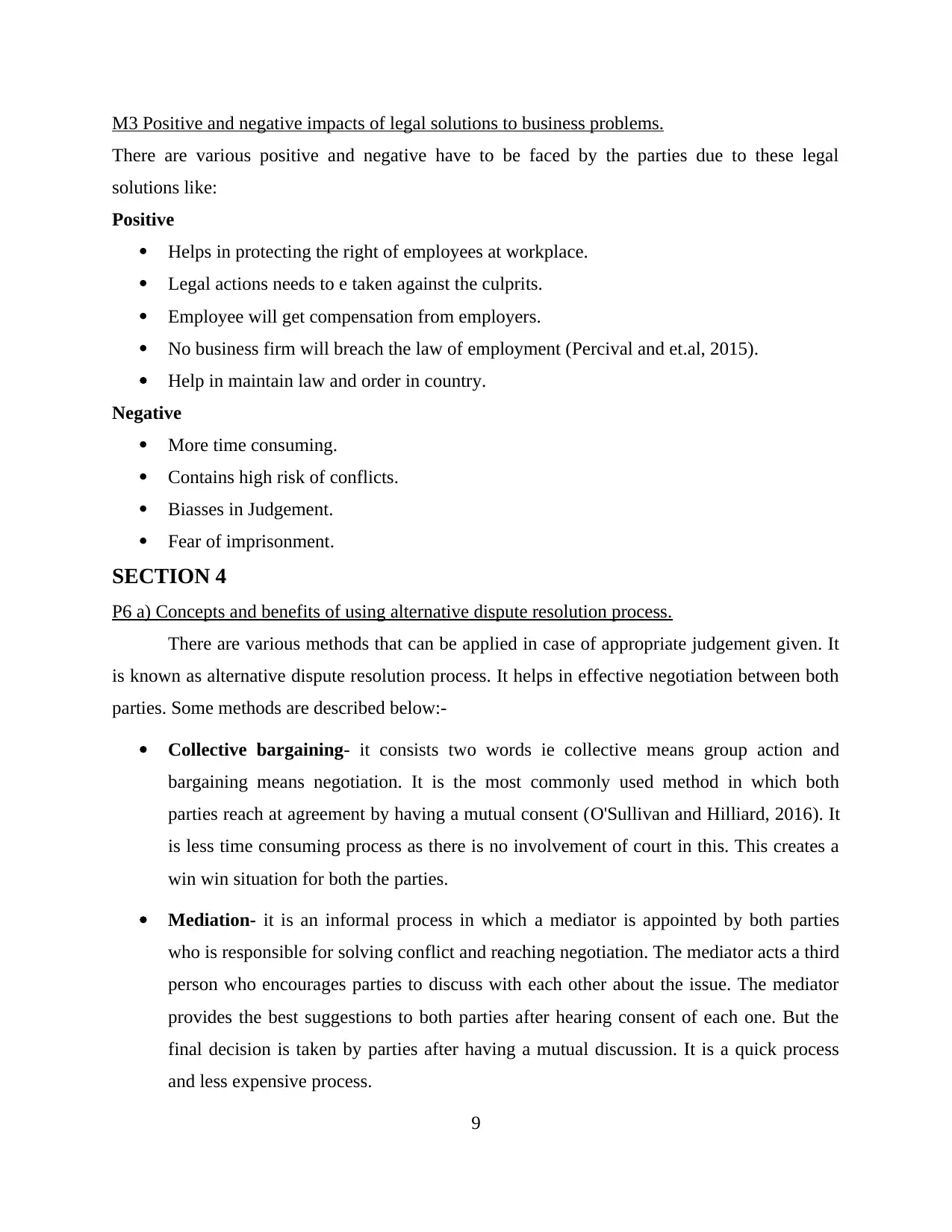
M3 Positive and negative impacts of legal solutions to business problems.
There are various positive and negative have to be faced by the parties due to these legal
solutions like:
Positive
Helps in protecting the right of employees at workplace.
Legal actions needs to e taken against the culprits.
Employee will get compensation from employers.
No business firm will breach the law of employment (Percival and et.al, 2015).
Help in maintain law and order in country.
Negative
More time consuming.
Contains high risk of conflicts.
Biasses in Judgement.
Fear of imprisonment.
SECTION 4
P6 a) Concepts and benefits of using alternative dispute resolution process.
There are various methods that can be applied in case of appropriate judgement given. It
is known as alternative dispute resolution process. It helps in effective negotiation between both
parties. Some methods are described below:-
Collective bargaining- it consists two words ie collective means group action and
bargaining means negotiation. It is the most commonly used method in which both
parties reach at agreement by having a mutual consent (O'Sullivan and Hilliard, 2016). It
is less time consuming process as there is no involvement of court in this. This creates a
win win situation for both the parties.
Mediation- it is an informal process in which a mediator is appointed by both parties
who is responsible for solving conflict and reaching negotiation. The mediator acts a third
person who encourages parties to discuss with each other about the issue. The mediator
provides the best suggestions to both parties after hearing consent of each one. But the
final decision is taken by parties after having a mutual discussion. It is a quick process
and less expensive process.
9
There are various positive and negative have to be faced by the parties due to these legal
solutions like:
Positive
Helps in protecting the right of employees at workplace.
Legal actions needs to e taken against the culprits.
Employee will get compensation from employers.
No business firm will breach the law of employment (Percival and et.al, 2015).
Help in maintain law and order in country.
Negative
More time consuming.
Contains high risk of conflicts.
Biasses in Judgement.
Fear of imprisonment.
SECTION 4
P6 a) Concepts and benefits of using alternative dispute resolution process.
There are various methods that can be applied in case of appropriate judgement given. It
is known as alternative dispute resolution process. It helps in effective negotiation between both
parties. Some methods are described below:-
Collective bargaining- it consists two words ie collective means group action and
bargaining means negotiation. It is the most commonly used method in which both
parties reach at agreement by having a mutual consent (O'Sullivan and Hilliard, 2016). It
is less time consuming process as there is no involvement of court in this. This creates a
win win situation for both the parties.
Mediation- it is an informal process in which a mediator is appointed by both parties
who is responsible for solving conflict and reaching negotiation. The mediator acts a third
person who encourages parties to discuss with each other about the issue. The mediator
provides the best suggestions to both parties after hearing consent of each one. But the
final decision is taken by parties after having a mutual discussion. It is a quick process
and less expensive process.
9
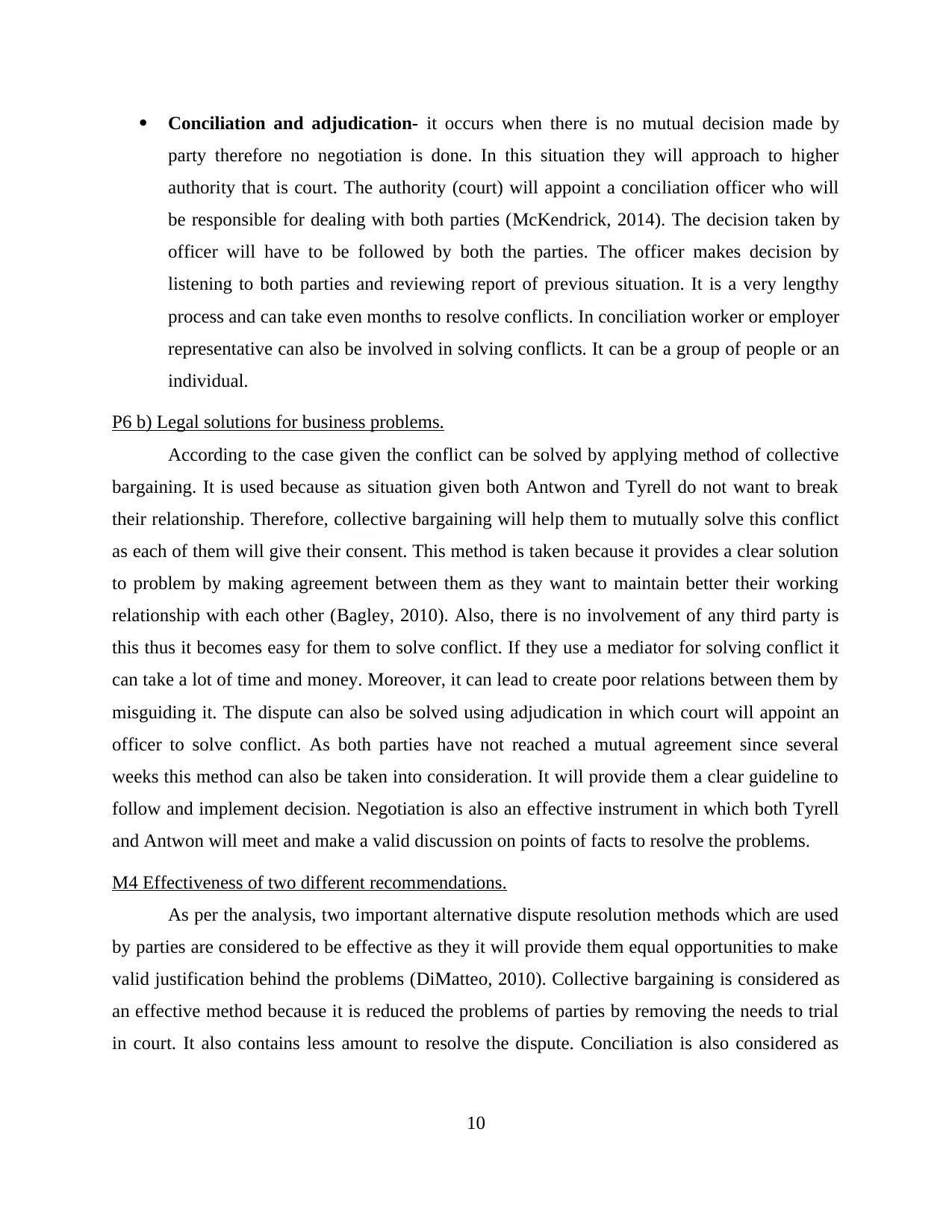
Conciliation and adjudication- it occurs when there is no mutual decision made by
party therefore no negotiation is done. In this situation they will approach to higher
authority that is court. The authority (court) will appoint a conciliation officer who will
be responsible for dealing with both parties (McKendrick, 2014). The decision taken by
officer will have to be followed by both the parties. The officer makes decision by
listening to both parties and reviewing report of previous situation. It is a very lengthy
process and can take even months to resolve conflicts. In conciliation worker or employer
representative can also be involved in solving conflicts. It can be a group of people or an
individual.
P6 b) Legal solutions for business problems.
According to the case given the conflict can be solved by applying method of collective
bargaining. It is used because as situation given both Antwon and Tyrell do not want to break
their relationship. Therefore, collective bargaining will help them to mutually solve this conflict
as each of them will give their consent. This method is taken because it provides a clear solution
to problem by making agreement between them as they want to maintain better their working
relationship with each other (Bagley, 2010). Also, there is no involvement of any third party is
this thus it becomes easy for them to solve conflict. If they use a mediator for solving conflict it
can take a lot of time and money. Moreover, it can lead to create poor relations between them by
misguiding it. The dispute can also be solved using adjudication in which court will appoint an
officer to solve conflict. As both parties have not reached a mutual agreement since several
weeks this method can also be taken into consideration. It will provide them a clear guideline to
follow and implement decision. Negotiation is also an effective instrument in which both Tyrell
and Antwon will meet and make a valid discussion on points of facts to resolve the problems.
M4 Effectiveness of two different recommendations.
As per the analysis, two important alternative dispute resolution methods which are used
by parties are considered to be effective as they it will provide them equal opportunities to make
valid justification behind the problems (DiMatteo, 2010). Collective bargaining is considered as
an effective method because it is reduced the problems of parties by removing the needs to trial
in court. It also contains less amount to resolve the dispute. Conciliation is also considered as
10
party therefore no negotiation is done. In this situation they will approach to higher
authority that is court. The authority (court) will appoint a conciliation officer who will
be responsible for dealing with both parties (McKendrick, 2014). The decision taken by
officer will have to be followed by both the parties. The officer makes decision by
listening to both parties and reviewing report of previous situation. It is a very lengthy
process and can take even months to resolve conflicts. In conciliation worker or employer
representative can also be involved in solving conflicts. It can be a group of people or an
individual.
P6 b) Legal solutions for business problems.
According to the case given the conflict can be solved by applying method of collective
bargaining. It is used because as situation given both Antwon and Tyrell do not want to break
their relationship. Therefore, collective bargaining will help them to mutually solve this conflict
as each of them will give their consent. This method is taken because it provides a clear solution
to problem by making agreement between them as they want to maintain better their working
relationship with each other (Bagley, 2010). Also, there is no involvement of any third party is
this thus it becomes easy for them to solve conflict. If they use a mediator for solving conflict it
can take a lot of time and money. Moreover, it can lead to create poor relations between them by
misguiding it. The dispute can also be solved using adjudication in which court will appoint an
officer to solve conflict. As both parties have not reached a mutual agreement since several
weeks this method can also be taken into consideration. It will provide them a clear guideline to
follow and implement decision. Negotiation is also an effective instrument in which both Tyrell
and Antwon will meet and make a valid discussion on points of facts to resolve the problems.
M4 Effectiveness of two different recommendations.
As per the analysis, two important alternative dispute resolution methods which are used
by parties are considered to be effective as they it will provide them equal opportunities to make
valid justification behind the problems (DiMatteo, 2010). Collective bargaining is considered as
an effective method because it is reduced the problems of parties by removing the needs to trial
in court. It also contains less amount to resolve the dispute. Conciliation is also considered as
10
⊘ This is a preview!⊘
Do you want full access?
Subscribe today to unlock all pages.

Trusted by 1+ million students worldwide
1 out of 15
Related Documents
Your All-in-One AI-Powered Toolkit for Academic Success.
+13062052269
info@desklib.com
Available 24*7 on WhatsApp / Email
![[object Object]](/_next/static/media/star-bottom.7253800d.svg)
Unlock your academic potential
Copyright © 2020–2025 A2Z Services. All Rights Reserved. Developed and managed by ZUCOL.





